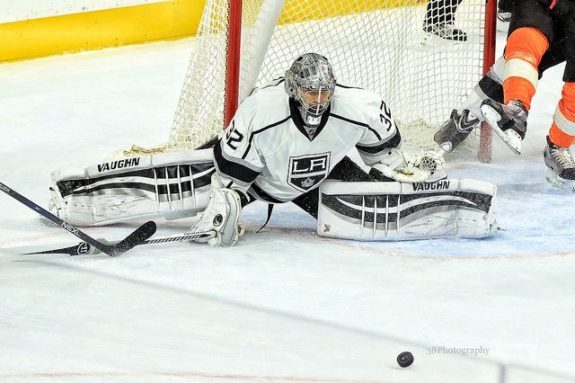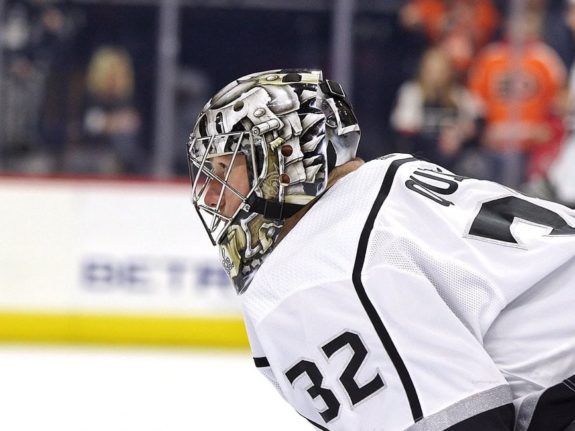Jonathan Quick has been a staple in the LA Kings’ net for over a decade. In the past few seasons, however, it looked like time had caught up to the 35-year-old goaltender. In an otherwise streaky season in 2021-22 for the Kings, Quick has stood out as a bright spot thanks to his recent return to being an elite NHL goalie. Here’s a look at the factors that led to this resurgence and what it means for the team going forward.
Quick’s Play Over the Years
Having played a handful of games in the 2007-2008 season, Quick truly burst onto the scene in 2008-09 when in 44 games, he had a 2.48 goals-against average (GAA) and a .914 save percentage (SV%). It was impressive for a rookie, but his true dominance was from 2011-12 to 2017-18 when he won two Stanley Cups (2012 and 2014), the Conn Smythe Trophy (as playoff MVP in 2012), the William M. Jennings Trophy (awarded to the goaltenders on a team with the fewest GAA) twice (2014 and 2018), was a two-time Vezina Trophy nominee (2012 and 2016), and was invited to the NHL All-Star Game three times (2012, 2016, and 2018). These honors easily place him among the top goalies of all time; yet, after the 2017-2018 season, his game went downhill.
Related: Revisiting Jonathan Quick’s Legendary 2012 Playoffs
In 46 games in 2018-19, Quick posted a 3.38 GAA and a .888 SV%; he had a 2.40 GAA and 9.21 SV% in 64 games the season before. The following season, his numbers improved slightly. In the pandemic-shortened 2019-2020 season, he posted a 2.79 GAA and .904 SV% in 42 games. However, considering his age and lack of consistent play, the team started to rely more on Jack Campbell and then, after Campbell was traded in early 2020, rookie netminder Calvin Peterson, who immediately put up better numbers than the veteran Quick. Near the end of 2019-20, the two essentially split starts. By the end of the 2020-21 season, Peterson seemed to have taken over as the team’s first-string goaltender with 35 starts compared to Quick’s 22.
Quick’s Downfall
It is hard to believe that in one season, Quick went from being an elite, All-Star-caliber goalie to being ranked 74th in SV% among goalies with a minimum of 20 games played. Two factors played a role in this, the team’s overall play and Quick’s.
Team Factors
During Quick’s worst years (late 2018 to early 2021), the Kings were also struggling, but there was also a shift in the NHL. Starting in the late 2010s, emerging players put a greater emphasis on speed and skill. The Kings, still largely comprised of their Cup-winning roster, still stressed defensive ability, and they simply could not compete against the speed and skill of the modern NHL.

From 2018-19 until the 2020-21 campaigns, the Kings failed to reach a .500 winning percentage with goal differentials of minus-61, minus-34, and minus-27. The team also started trading away veteran blueliners, such as Jake Muzzin and Alec Martinez, to secure the assets, draft picks and prospects, necessary to start building a team that could compete in the new era. As a result, the Kings’ defense was inexperienced aside from Drew Doughty, which contributed to Quick’s poor numbers.
Quick-Related Factors
Quick’s uniquely aggressive style depended on pure athleticism and flexibility, which he could not maintain as he got older, and his numbers suffered as a result. This wasn’t helped by a lengthy injury history, especially groin injuries, which likely impacted his flexibility. Nevertheless, while his age played a role in limiting his athleticism, it was not the sole reason; when healthy, he was still physically able to play his trademark style. So, like his team’s, his playing style was the problem.
The NHL’s emphasis on speed and skill necessitated a change in how Quick played the game. In the more physical, shoot-first style of the early 2010s, he used his aggressiveness to cut down initial shots, and his flexibility could bail him out on second attempts. Simply put, his athleticism could cover for relatively poor positioning. However, by the late 2010s, players started to look for more slick passing opportunities, especially around the net, and his flexibility and his agility were not enough to make a save if he was way out of his crease.

While players should always strive to improve, at a certain point age, among other factors, make it hard to adopt new a new style. Changing his game wasn’t an easy ask, especially for a successful veteran. But, he needed to change his positioning to continue to be successful in today’s NHL. So, for a time, it seemed that he wouldn’t be able to return to elite form, but Quick altered his game, evident by his dominant 2021-22 campaign so far.
Quick’s Resurgence
Heading into the 2021-22 season, most expected Quick and Peterson to split starts unless and until Peterson proved that he was ready to claim the number one spot. Most were wrong: Quick has returned to elite form. Among NHL goalies with a minimum of 14 games played, his 2.18 GAA ranks eighth, and his .930 SV% is tied for sixth. He also ranks first in SV% above expected and second in goals saved above expected; he is playing far better than even expert statisticians could have predicted.
This is not a situation where a thriving young team has impacted their goaltender’s stats. While the Kings have made drastic strides to return to form, the team is not good enough to inflate Quick’s numbers. In fact, he has been keeping the Kings in games that they would never have had a chance to win. Yet, he was able to pinpoint his biggest problem and make the necessary adjustments without compromising the style that makes his play so unique.
Quick has improved the technical aspects of his game by placing himself deeper in his crease. Instead of leaving the blue paint to cut down the angles, he has been maximizing his ability to take the initial shot and save any subsequent pass or rebound by playing a more positionally sound game. This has allowed him to make some incredible, highlight-worthy saves that would have been quite difficult with overly aggressive positioning, even in his prime.
This phenomenal save against the Tampa Bay Lightning’s Ondrej Palat shows how Quick’s adjustments have complemented his athleticism and flexibility. He never leaves the blue paint, which, until recently, he would have been more aggressive trying to force the initial shot. Nevertheless, he was still fully prepared for a shot, and his positioning allowed him to use his flexibility to immediately shift when the pass to Palat was made, resulting in a save that almost no other goalie could have made; it is just one of many amazing saves Quick has made this season.
Kings’ Goaltending Situation Going Forward
Despite his strong play, Quick is 35 years old, and it’s hard to predict how much longer he’ll be able to maintain his style of play, especially since it is still largely dependent on his flexibility. Also, his contract ends following the 2022-23 season. While the Kings may elect to re-sign their franchise goaltender, it’s time to think about who will take the helm when he retires. Peterson is the obvious choice. The young goalie plays a technically sound game that complements the modern NHL, and he has already shown flashes of brilliance.
Nevertheless, Quick will likely hold on to his title as the Kings’ number one goalie for the near future because his play warrants it, and Peterson is learning that it won’t be easy to take the starting job from Quick. The Kings can benefit from this healthy competition between the two netminders, as Quick strives to prove that he is still an elite goalie and Peterson seeks to establish himself as the team’s future. The team will happily welcome a situation where they have two elite goaltenders, and given Quick’s play as of late, it is entirely possible.
Stats per NHL, QuantHockey, and Money Puck